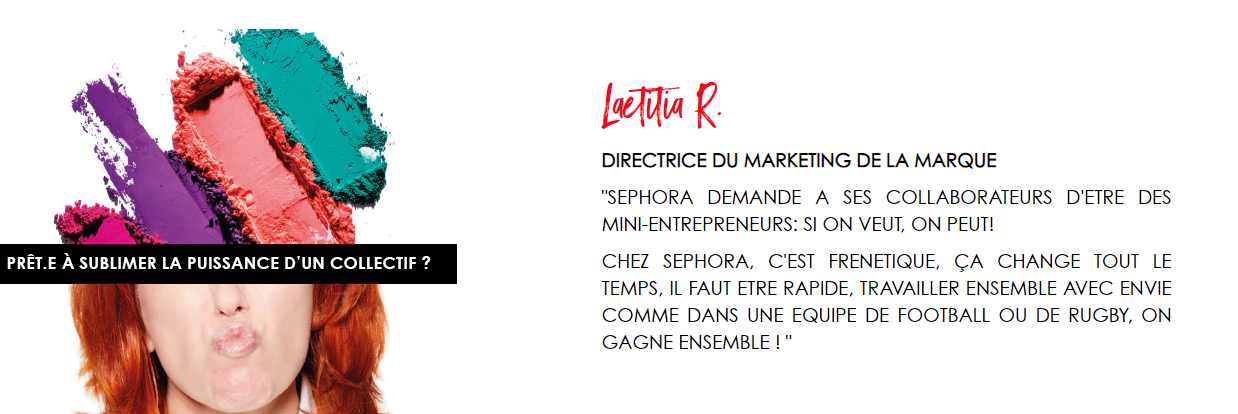Sephora began in the 1970s when founder Dominique Mandonnaud disrupted his industry by taking beauty products off the counter.
The French were curious at the time and were massively tempted by the Sephora experience.
Today, Sephora is one of the world's leading beauty retailers, with more than 35,000 employees, a community of more than 100 million customers and a presence in more than 35 markets around the world.
However, despite the strength and reputation of the Sephora brand, studies have shown that Sephora's external appeal and image as an employer (its famous Employer Brand) did not fully reflect the internal experience and strong employee engagement with the company.
In addition, the company's rapid organic growth over a decade led to a variety of approaches around the world/
This required a more coordinated and intentional approach globally to ensure that all talent received the same value proposition (EVP for Employee Value Proposition).
Create a culture- and commonality-focused EVP
It was important for Sephora to create an authentic, global EVP. Problem: these terms tend to be mutually exclusive!
The group chose to highlight Sephora's vision and DNA, both of which are consistent and common throughout the world.
To identify them, Sephora discovered 4 key strengths that resonated with current and future talent:
- Making an impact in beauty and beyond
- Embracing innovation, exploration and creativity
- Promote learning and evolution
- Celebrate diversity, uniqueness and inclusion

Based on these strengths, Sephora has developed global EVP pillars and an employer brand manifesto.
This manifesto combines all of the elements of Sephora's EVP pillars, identifies the emotion they provide, and shares that feeling in a sort of "rallying cry" that underscores what an employer they are.
Group employees are united by a common goal: reinventing the future of beauty.
"EVP is a great way to help our employees celebrate our culture, to share their stories and successes, and to feel a feeling of solidarity. " (Stephen Bobko, VP HR Sephora)
Meeting and overcoming challenges
The EVP and Sephora Manifesto were successfully launched and embraced by talent around the world. But the process has not been without its challenges.
- How to organize expertise to create your employer brand?
Sephora knew all the great things that were being done on a daily basis for employees.
But how do you share them with the world without falling into the heaviness of self-promotion?
To do this, Sephora was able to both mobilize its in-house teams, particularly marketing and HR employees, and then find a partner of excellence to build their communications, in this case the Canadian agency Bluivy Group.
- How to get global membership?
When you walk into a Sephora store anywhere in the world, you know you're shopping at Sephora: there is indeed that fun, playful atmosphere, as well as clear visual cues that help create a unique experience.
The goal of the Employer Brand is to create that same sense of unity and consistency for the global EVP.
To achieve this, Sephora has involved many people throughout the process: HR partners, managers from all functions, store and headquarters employees, trying to be as transparent as possible about the process and developing the EVP as a collaborative effort.

- How to balance global and local?
While it was important for Sephora to create a consistent global EVP, it was equally important to build a flexible framework that would allow each region to take ownership of the EVP, bring it to life authentically, and showcase unique local strengths.
To do this, Sephora clearly defined what would remain global - the common message - and what could be personalized to be relevant to local talent.
By doing this and helping each region develop its own content with the overall message as a general foundation, the Sephora team was able to strike the right balance and build a "Glocal" EPV and reflect it on their careers site.
What are the results?
In late 2020, Sephora began activating its global EVP - internally first, then externally - with targeted messaging, communication assets and toolkits, visual guidelines, storytelling contests, etc.
While each region is at a different stage of activation, Sephora is already starting to see tangible results.
Here's what the project manager on the Sephora side reports:
"The first thing we noticed is that our employees, wherever they are in the company, are taking ownership of the EVP message and bringing it to life"
"One day you're sharing a basic communication toolkit, and the next day you're seeing photos from all over the world showing posters, events, people embodying the work we've done together, both in stores and in our corporate offices!"
"We're also seeing a lot more communication between our HR communities, sharing best practices and questions they have about particular challenges."
"Online, we're seeing a big increase in talent engagement on our platforms-Linkedin, Instagram, etc. We're also getting early feedback from some of our HR managers around the world that the overall quality of candidates has improved since they started using EVP-aligned recruitment media," they concluded.

How to take it to the next level for Sephora?
Creating an Employer Brand platform and knowing its EVP in detail is the first step in an Inbound Recruiting.
In fact, it is vital, for the effort undertaken to be sustainable, to build on this communication foundation to deploy a true digital attractiveness strategy.
In fact, the challenge is not simply to convince those who already have a good image of Sephora because its employer brand is part of its commercial brand: its Employer Brand must be able to transcend its commercial brand!!
In other words, Sephora needs to know how to attract developers, data scientists, network engineers, B2B salespeople, etc.
Can it do this with its current definition of its employer brand? Probably not.
Can it do it with a targeted and optimized content strategy? Definitely!
Note: The writing of this article is based on a feedback conducted by BluIvy. Find the full article here.










